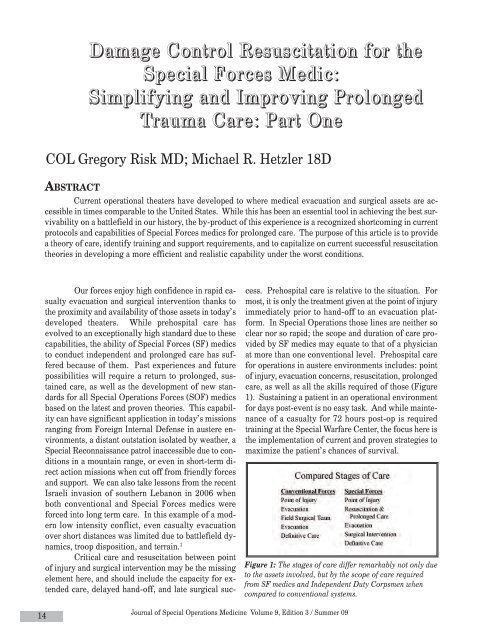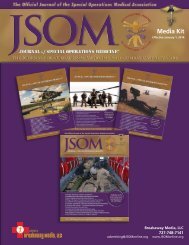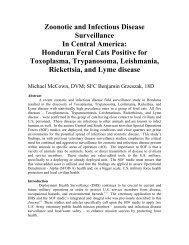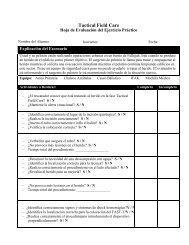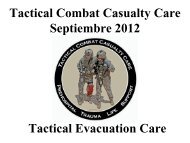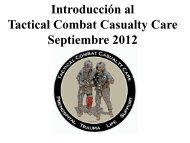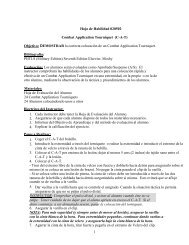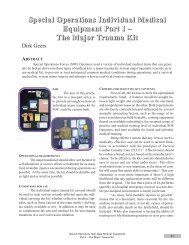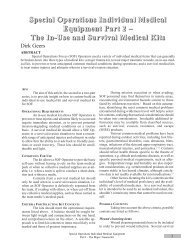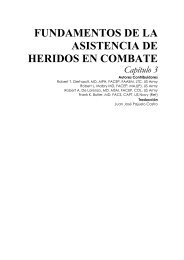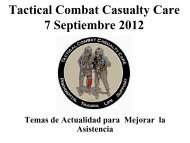Risk G. Hetzler M. Damage Control Resuscitation for the Special ...
Risk G. Hetzler M. Damage Control Resuscitation for the Special ...
Risk G. Hetzler M. Damage Control Resuscitation for the Special ...
You also want an ePaper? Increase the reach of your titles
YUMPU automatically turns print PDFs into web optimized ePapers that Google loves.
<strong>Damage</strong> <strong>Control</strong> <strong>Resuscitation</strong> <strong>for</strong> <strong>the</strong><br />
<strong>Special</strong> Forces Medic:<br />
Simplifying and Improving Prolonged<br />
Trauma Care: Part One<br />
COL Gregory <strong>Risk</strong> MD; Michael R. <strong>Hetzler</strong> 18D<br />
ABSTRACT<br />
Current operational <strong>the</strong>aters have developed to where medical evacuation and surgical assets are accessible<br />
in times comparable to <strong>the</strong> United States. While this has been an essential tool in achieving <strong>the</strong> best survivability<br />
on a battlefield in our history, <strong>the</strong> by-product of this experience is a recognized shortcoming in current<br />
protocols and capabilities of <strong>Special</strong> Forces medics <strong>for</strong> prolonged care. The purpose of this article is to provide<br />
a <strong>the</strong>ory of care, identify training and support requirements, and to capitalize on current successful resuscitation<br />
<strong>the</strong>ories in developing a more efficient and realistic capability under <strong>the</strong> worst conditions.<br />
Our <strong>for</strong>ces enjoy high confidence in rapid casualty<br />
evacuation and surgical intervention thanks to<br />
<strong>the</strong> proximity and availability of those assets in today’s<br />
developed <strong>the</strong>aters. While prehospital care has<br />
evolved to an exceptionally high standard due to <strong>the</strong>se<br />
capabilities, <strong>the</strong> ability of <strong>Special</strong> Forces (SF) medics<br />
to conduct independent and prolonged care has suffered<br />
because of <strong>the</strong>m. Past experiences and future<br />
possibilities will require a return to prolonged, sustained<br />
care, as well as <strong>the</strong> development of new standards<br />
<strong>for</strong> all <strong>Special</strong> Operations Forces (SOF) medics<br />
based on <strong>the</strong> latest and proven <strong>the</strong>ories. This capability<br />
can have significant application in today’s missions<br />
ranging from Foreign Internal Defense in austere environments,<br />
a distant outstation isolated by wea<strong>the</strong>r, a<br />
<strong>Special</strong> Reconnaissance patrol inaccessible due to conditions<br />
in a mountain range, or even in short-term direct<br />
action missions when cut off from friendly <strong>for</strong>ces<br />
and support. We can also take lessons from <strong>the</strong> recent<br />
Israeli invasion of sou<strong>the</strong>rn Lebanon in 2006 when<br />
both conventional and <strong>Special</strong> Forces medics were<br />
<strong>for</strong>ced into long term care. In this example of a modern<br />
low intensity conflict, even casualty evacuation<br />
over short distances was limited due to battlefield dynamics,<br />
troop disposition, and terrain. 1<br />
Critical care and resuscitation between point<br />
of injury and surgical intervention may be <strong>the</strong> missing<br />
element here, and should include <strong>the</strong> capacity <strong>for</strong> extended<br />
care, delayed hand-off, and late surgical success.<br />
Prehospital care is relative to <strong>the</strong> situation. For<br />
most, it is only <strong>the</strong> treatment given at <strong>the</strong> point of injury<br />
immediately prior to hand-off to an evacuation plat<strong>for</strong>m.<br />
In <strong>Special</strong> Operations those lines are nei<strong>the</strong>r so<br />
clear nor so rapid; <strong>the</strong> scope and duration of care provided<br />
by SF medics may equate to that of a physician<br />
at more than one conventional level. Prehospital care<br />
<strong>for</strong> operations in austere environments includes: point<br />
of injury, evacuation concerns, resuscitation, prolonged<br />
care, as well as all <strong>the</strong> skills required of those (Figure<br />
1). Sustaining a patient in an operational environment<br />
<strong>for</strong> days post-event is no easy task. And while maintenance<br />
of a casualty <strong>for</strong> 72 hours post-op is required<br />
training at <strong>the</strong> <strong>Special</strong> Warfare Center, <strong>the</strong> focus here is<br />
<strong>the</strong> implementation of current and proven strategies to<br />
maximize <strong>the</strong> patient’s chances of survival.<br />
Figure 1: The stages of care differ remarkably not only due<br />
to <strong>the</strong> assets involved, but by <strong>the</strong> scope of care required<br />
from SF medics and Independent Duty Corpsmen when<br />
compared to conventional systems.<br />
14<br />
Journal of <strong>Special</strong> Operations Medicine Volume 9, Edition 3 / Summer 09
This article is <strong>the</strong> first of two meant to provide<br />
an approach to critical care using damage control resuscitation<br />
(DCR) as a guideline adapted <strong>for</strong> our use. DCR<br />
is a current and proven practice and provides aggressive<br />
and effective trauma management with minimal support<br />
while preparing <strong>the</strong> patient <strong>for</strong> <strong>the</strong> next level of care.<br />
DCR consists of two parts: first, keeping blood pressure<br />
at approximately 90mmHg, and second, to rapidly reverse<br />
coagulopathy and restore oxygen carrying capacity<br />
with fresh frozen plasma (FFP) and packed red blood<br />
cells (PRBC). 2 Since FFP and PRBCs are unavailable<br />
far <strong>for</strong>ward, we are advocating <strong>the</strong> earlier and more aggressive<br />
use of type-specific fresh whole blood (FWB) as<br />
<strong>the</strong> only workable solution <strong>for</strong> salvaging patients with<br />
life-threatening injuries. Fresh whole blood delivers normal<br />
physiological ratios of essential elements, with more<br />
active clotting factors than banked component blood, and<br />
at normo<strong>the</strong>rmic temperatures. 3 Indications <strong>for</strong> FWB use<br />
is based on patient presentation and lab results such as<br />
lactate, base deficit, pH, and hematocrit which will also<br />
later serve as endpoints in resuscitation, ensuring efficient<br />
<strong>the</strong>rapeutic objectives. While “balanced” or “hypotensive”<br />
resuscitation works well in <strong>the</strong> short term, a<br />
patient left hypotensive and under-resuscitated <strong>for</strong> a prolonged<br />
period cannot be sustained. Trauma patients who<br />
do not normalize <strong>the</strong>ir pH or base deficit have significantly<br />
higher mortality at 24 hours and near universal<br />
mortality at 48 hours. 4<br />
Patient care in <strong>the</strong> austere environment is incomparable<br />
to that in a U.S. hospital. With that in mind,<br />
<strong>the</strong> scope of practice, <strong>the</strong>rapeutic guidelines, procedures<br />
used, benefit vs. risk analysis, and clinical tenets, significantly<br />
differ from a civilian emergency room or even<br />
that of a combat surgical hospital (CSH). Many may<br />
question <strong>the</strong> standards of care recommended, but <strong>the</strong>y<br />
probably do not appreciate <strong>the</strong> challenges SF medics<br />
face. Prolonged care in <strong>the</strong> primitive setting cannot support<br />
current hospital-based parameters, and a return to<br />
unconventional warfare practices is warranted and necessary.<br />
Strict clinical practices are respected and exercised,<br />
but not always attainable in our environment.<br />
Careful review of many long <strong>for</strong>gotten practices from<br />
previous conflicts may yield surprising results. The use<br />
of tourniquets, damage control surgery, and plasma and<br />
whole blood transfusions, are all being resurrected with<br />
improved patient outcomes in <strong>the</strong> 21st century. Many believe<br />
<strong>the</strong> most difficult challenges are found in <strong>the</strong> austere<br />
environment, and this may be where DCR is of most<br />
benefit.<br />
The following recommendations to SF medic’s<br />
were ga<strong>the</strong>red from a number of physicians and institutions<br />
that have compiled an impressive bank of credible<br />
and groundbreaking <strong>the</strong>ories over <strong>the</strong> last seven years.<br />
Our ef<strong>for</strong>t here is to capitalize on those lifesaving protocols,<br />
merge <strong>the</strong> conventional levels of care with our<br />
overlapping SOF capabilities, and apply <strong>the</strong>m in our rigorous<br />
environment.<br />
OVERVIEW<br />
The Tactical Combat Casualty Care Committee<br />
(TCCC) has continually updated guidelines since 1996<br />
<strong>for</strong> prehospital care on <strong>the</strong> battlefield as defined in three<br />
levels: Care Under Fire, Tactical Field Care, and Tactical<br />
Evacuation Care. These guidelines are based on<br />
medic, corpsman, and physician input and experiences<br />
through quarterly conferences. However, TCCC guidelines<br />
only provide <strong>the</strong> basis <strong>for</strong> care at <strong>the</strong> point of injury<br />
through evacuation. This article maintains those guidelines,<br />
but will leave initial management behind as SF<br />
medics move on to 12 to 96 hours post event.<br />
<strong>Damage</strong> control surgery (DCS) is a well established<br />
and proven modality of medical intervention in<br />
both civilian and military practice. 5 The U.S. Army Institute<br />
of Surgical Research (ISR) has provided <strong>the</strong> most<br />
up-to-date collection, evaluation, and development of<br />
critical care <strong>for</strong> war wounded, and additionally has<br />
driven implementation of this <strong>the</strong>ory within all <strong>the</strong> services.<br />
<strong>Damage</strong> control focuses on principles that allow<br />
<strong>for</strong> highly efficient care while compensating <strong>for</strong> inexperience<br />
and limited resources as <strong>the</strong> “great equalizer” of<br />
trauma surgery. 6 Using <strong>the</strong> damage control model <strong>for</strong> a<br />
ship, <strong>the</strong> goal is to rapidly implement measures that prevent<br />
fur<strong>the</strong>r deterioration be<strong>for</strong>e irreversible injury occurs,<br />
or “<strong>the</strong> ship sinks.” Most initial treatments are<br />
temporary to minimize patient exposure to stressful surgical<br />
conditions and to reduce a physiological loss which<br />
maximizes <strong>the</strong> patient’s preparation <strong>for</strong> more extensive<br />
care. Definitive surgical repair of injuries prior to adequate<br />
resuscitation may lead to a fully repaired but unsalvageable<br />
patient. The primary and most immediate<br />
goal is surgical control of hemorrhage with judicious<br />
fluid resuscitation, which is accomplished with a number<br />
of advanced surgical procedures such as rapid closure,<br />
shunting, or packing. Stopping fur<strong>the</strong>r<br />
contamination through exploration and additional <strong>the</strong>rapeutic<br />
serves as a concurrent ef<strong>for</strong>t and significantly<br />
decreases septic effects that can impact mortality over<br />
time. The patient <strong>the</strong>n moves to <strong>the</strong> intensive care unit<br />
to receive resuscitative care preparing him <strong>for</strong> return to<br />
<strong>the</strong> operating room within 24 to 48 hours <strong>for</strong> definitive<br />
surgical repair. Understanding this entire process is<br />
paramount to “act tactically, but think strategically” 7 in<br />
preparing patients <strong>for</strong> a successful outcome. This treatment<br />
strategy must be understood to prepare <strong>the</strong> patient<br />
<strong>Damage</strong> <strong>Control</strong> <strong>Resuscitation</strong> <strong>for</strong> <strong>the</strong> <strong>Special</strong> Forces Medic:<br />
Simplifying and Improving Prolonged Trauma Care: Part One<br />
15
at this level; <strong>the</strong> SOF medics primary goal is to ensure that<br />
<strong>the</strong> patients arrive at surgical assets properly resuscitated.<br />
Figure 2: The lethal triad easily visualized, attributed to<br />
Colonel John Holcomb.<br />
<strong>Damage</strong> control resuscitation guidelines are<br />
specifically focused on <strong>the</strong> prevention of <strong>the</strong> “lethal triad”<br />
consisting of hypo<strong>the</strong>rmia, coagulapathy, and acidosis; all<br />
of which can be ei<strong>the</strong>r mutually supporting or mutually<br />
destructive (see Figure 2). The factors of <strong>the</strong> lethal triad<br />
are all proven independent and codependent indicators of<br />
mortality which also apply to DCS. <strong>Damage</strong> control resuscitation<br />
guidelines also include aggressive hypotensive<br />
and hemostatic resuscitation while providing parameters<br />
<strong>for</strong> addressing all three areas of <strong>the</strong> lethal triad. Ensuring<br />
that <strong>the</strong>se ef<strong>for</strong>ts are proactive and continuous from <strong>the</strong><br />
point of injury provides <strong>the</strong> most efficient care possible<br />
and uses a more scientific and <strong>the</strong>rapeutic approach to<br />
combat trauma <strong>for</strong> SOF medics. Again, <strong>the</strong> medics care<br />
can and should potentiate success in supporting both<br />
TCCC and DCS in <strong>the</strong> hospital.<br />
Figure 3: An OSS doctor conducts minor surgery in China circa 1944.<br />
(Courtesy USASOC Historian’s Office)<br />
IMPORTANCE OF HEMOSTASIS<br />
The single most essential weapon <strong>for</strong> DCR is<br />
immediate and effective hemostasis, and it is at <strong>the</strong> point<br />
of injury where resuscitation begins <strong>for</strong> <strong>the</strong> SOF medic.<br />
Hemorrhage control is <strong>the</strong> conservation of every single<br />
drop of blood and with it every key ingredient that provides<br />
success against <strong>the</strong> lethal triad. The loss of blood<br />
leads to hypoperfusion of tissues, relative hypoxia, and<br />
promotes anaerobic metabolism. This subsequently<br />
promotes acidosis, hypo<strong>the</strong>rmia, and loses key coagulation<br />
factors that are not easily reclaimed. Minimizing<br />
blood loss by immediate and effective treatments is a<br />
fundamental trauma skill. Perfecting <strong>the</strong> basics will<br />
gain hemorrhage control in <strong>the</strong> least amount of time and<br />
with minimal supplies while increasing survivability<br />
with DCR.<br />
The physiologic picture resulting from hemorrhage<br />
easily demonstrates <strong>the</strong> interacting and accumulating<br />
factors that will be important later. Blood loss<br />
not only includes red blood cells essential <strong>for</strong> tissue<br />
oxygenation but also critical coagulation components<br />
such as platelets, clotting factors, and enzymes. Currently<br />
<strong>the</strong>se factors can only be replenished in <strong>the</strong> most<br />
difficult procedures <strong>for</strong> <strong>the</strong> SF medic, especially when<br />
time, enemy situation, and supplies may all be at odds.<br />
A loss of blood volume reduces total oxygen carrying<br />
capability, which is compensated by increases in both<br />
inotropic (contractility) and chronotropic (heart rate) ef<strong>for</strong>t<br />
until <strong>the</strong> mismatch in oxygen delivery and demand<br />
result in tissue hypoxia, or true shock. At this point, <strong>the</strong><br />
affected tissues convert from aerobic to anaerobic metabolism,<br />
which exacerbates all three components of <strong>the</strong><br />
lethal triad. Cellular hypoxia results in a 90%<br />
reduction in energy production and an increased<br />
rate of lactate production promoting<br />
metabolic acidosis. This action leads to cellular<br />
swelling and edema, which fur<strong>the</strong>r diminishes<br />
capillary flow and microcirculation<br />
irrespective of mean arterial pressure (MAP).<br />
Additional hypoperfusion due to vasoconstriction<br />
occurs naturally and simultaneously by<br />
lowered blood pressure, pain, and cortical<br />
recognition of injury. A lack of blood supply<br />
to <strong>the</strong> liver results in decreased glucose and<br />
clotting factors fur<strong>the</strong>r complicating coagulapathies.<br />
O<strong>the</strong>r physiological damage occurs<br />
when pro-inflammatory mediators are released<br />
due to hemorrhage and tissue damage, and<br />
shock affects neuroendocrine responses producing<br />
severe metabolic changes. 8<br />
Direct pressure is always <strong>the</strong> first step <strong>for</strong><br />
hemostasis. As soon as hemorrhage is noted, dig-<br />
16<br />
Journal of <strong>Special</strong> Operations Medicine Volume 9, Edition 3 / Summer 09
Figure 4 : A <strong>Special</strong> Forces medic conducts an I & D<br />
procedure in Bolivia in 1967.<br />
(Courtesy USASOC Historian’s Office)<br />
ital or manual pressure is paramount and almost always<br />
assures immediate effectiveness. Remember, <strong>the</strong> goal<br />
is not just to limit <strong>the</strong> amount of blood loss, but to save<br />
every single drop possible. Paramount towards this end<br />
is <strong>the</strong> expectation that each Soldier, if able, per<strong>for</strong>ms<br />
self-care. This requires mental preparation, muscle<br />
memory, and psychological hardening to per<strong>for</strong>m under<br />
physical pain, stress, and challenging conditions. Pressure<br />
points are next, or act as an adjunct to minimize<br />
blood loss and always attempt to use o<strong>the</strong>r Soldiers to<br />
deal with pressure points even under <strong>the</strong> best circumstances.<br />
The benefit is reduced time to hemostasis and<br />
preserved blood volume, while maintaining combat<br />
power during <strong>the</strong> fight. O<strong>the</strong>r essential multipliers include<br />
<strong>the</strong> medic placing pressure with his own knee<br />
while he works, or effective support from his teammates<br />
from prior cross-training or on-scene instruction.<br />
Tourniquets are extremely effective in <strong>the</strong> treatment of<br />
extremity wounds and <strong>the</strong>ir success since 9/11 is inarguable.<br />
There have been no reports of amputations during<br />
<strong>the</strong> conflict directly attributable to tourniquet usage.<br />
Remember that bleeding control is a graded response,<br />
so if a limb is mangled enough a tourniquet will likely<br />
be <strong>the</strong> first step in hemorrhage control. 9 Tourniquet effectiveness<br />
is based on <strong>the</strong> principles of ensuring <strong>the</strong>y<br />
are placed proximal to <strong>the</strong> wound, active bleeding stops,<br />
<strong>the</strong> distal pulse is absent, and that reassessment is frequent<br />
and continuous. Keep in mind that <strong>the</strong> duration<br />
a tourniquet is applied will bring new concerns in prolonged<br />
care. Present standards call <strong>for</strong> removal within<br />
two hours and, if conscious, <strong>the</strong> patient will remind <strong>the</strong><br />
medic of this with <strong>the</strong> pain that normally accompanies<br />
prolonged tourniquet use. Application over two hours<br />
can also predispose <strong>the</strong> patient to increased morbidity<br />
such as fasciotomies and amputations, all of which may<br />
later be <strong>the</strong> medic’s responsibility in this scenario. 10<br />
Converting a tourniquet to an effective pressure dressing<br />
as soon as possible while leaving <strong>the</strong> tourniquet loose<br />
and in place, <strong>for</strong> use if reapplication is necessary, will<br />
likely prevent issues later in prolonged care.<br />
Packing wounds is a science in itself, requiring<br />
effective technique, proper supplies, and completed with<br />
a pressure dressing to optimize <strong>the</strong> medic’s work. Making<br />
<strong>the</strong> decision to pack early is important too; packing<br />
is dependent on <strong>the</strong> patient’s ability to <strong>for</strong>m good clots<br />
and if too many factors are lost, <strong>the</strong>n packing will not<br />
be effective. Bowl-type wounds must be addressed immediately<br />
by packing with a maximum of two fingers<br />
using unrolled Kerlix® and working from <strong>the</strong> bottom of<br />
<strong>the</strong> wound up, left to right or circumferentially, as if filling<br />
a bucket. Finding and addressing all potential space<br />
in <strong>the</strong> wound to ensure that <strong>the</strong>re is no opportunity <strong>for</strong><br />
any leakage of blood is a difficult task, especially while<br />
packing blindly, in <strong>the</strong> dark, and under stress at speed.<br />
An effective packing job can provide hemostasis with a<br />
minimum amount of supplies. Packing should not only<br />
be reserved <strong>for</strong> bowl-type wounds but also used in<br />
anatomical girdle areas such as <strong>the</strong> groin or shoulder.<br />
Hemostatic agents provide additional tools <strong>for</strong> more difficult<br />
wounds but <strong>the</strong>y require thorough training, ideally<br />
during predeployment trauma training, to utilize effectively.<br />
The same rule applies <strong>for</strong> hemostatics as with<br />
packing: hemostatics + packing + pressure = success.<br />
Future technologies that are presently being developed<br />
<strong>for</strong> advanced hemostatics such as vessel closure and<br />
pressurized viscotic hemostatics may offer additional adjuncts<br />
in time.<br />
PREVENTION OF HYPOTHERMIA<br />
Within <strong>the</strong> lethal triad itself, <strong>the</strong> prevention of<br />
hypo<strong>the</strong>rmia is probably <strong>the</strong> simplest and most practiced<br />
ef<strong>for</strong>t <strong>for</strong> SOF medics. Hypo<strong>the</strong>rmia has significant effects<br />
and yields 100% mortality to severely traumatized<br />
patients with core temperatures less than 90ºF (32ºC). 11<br />
The goal is to maintain <strong>the</strong> casualty’s core temperature to<br />
greater than 95ºF (35ºC). Preventing hypo<strong>the</strong>rmia takes<br />
far less ef<strong>for</strong>t and time than attempting to treat it under<br />
combat conditions.<br />
Temperature monitoring should be as continuous<br />
as possible. Use every tool in sequence from skin<br />
color and extremity warmth, patient feedback, and mentation.<br />
Objective findings can be obtained from tools<br />
<strong>Damage</strong> <strong>Control</strong> <strong>Resuscitation</strong> <strong>for</strong> <strong>the</strong> <strong>Special</strong> Forces Medic:<br />
Simplifying and Improving Prolonged Trauma Care: Part One<br />
17
such as inexpensive temperature dots placed on <strong>the</strong> <strong>for</strong>ehead<br />
or intermittent temperatures taken with an oto-<strong>the</strong>rmometer,<br />
or use a digital rectal <strong>the</strong>rmometer <strong>for</strong><br />
continuous and high confidence readings. The fact that<br />
most wounded patients very often feel cold post-insult<br />
or <strong>the</strong> observance of spontaneous shivering, should always<br />
key <strong>the</strong> medic in to <strong>the</strong> above steps. In short, simply<br />
treat every single patient relentlessly <strong>for</strong><br />
hypo<strong>the</strong>rmia.<br />
Hypo<strong>the</strong>rmia prevention should start immediately<br />
post-injury. Consideration of heat loss goes handin-hand<br />
with <strong>the</strong> initial assessment and optimally should<br />
occur during <strong>the</strong> primary survey or just immediately<br />
<strong>the</strong>reafter. Most of this work can be accomplished by<br />
cross-trained teammates automatically and simultaneously<br />
as <strong>the</strong> medic treats. Plan, prepare, and practice<br />
hypo<strong>the</strong>rmia prevention during all aspects of training;<br />
immediately insulating patient contact with <strong>the</strong> ground,<br />
minimizing exposure during <strong>the</strong> primary exam, removing<br />
only wet clothing, and even keeping <strong>the</strong> patient clean<br />
are all essential principles decreasing heat loss. Use<br />
every opportunity to get <strong>the</strong> patient off <strong>the</strong> ground, dried<br />
if possible, covered, and out of <strong>the</strong> elements and begin<br />
all proactive ef<strong>for</strong>ts <strong>for</strong> economy of time.<br />
Both passive and active measures should be<br />
planned <strong>for</strong>. Standard commercial hypo<strong>the</strong>rmia kits<br />
should include a durable and effective solar blanket and<br />
a chemical warming blanket, and <strong>the</strong>se should be kept<br />
with litter kits. Open <strong>the</strong> warming blankets first as <strong>the</strong>y<br />
normally take some time to reach its full exo<strong>the</strong>rmic reaction.<br />
The solar blankets are normally vacuum sealed<br />
so it should be stretched to full size to open any incorporated<br />
air cells. Position it diagonally on <strong>the</strong> litter so<br />
that <strong>the</strong> head and feet lie on <strong>the</strong> longest ends of <strong>the</strong> blanket<br />
and move <strong>the</strong> casualty to <strong>the</strong> blanket as quickly as<br />
possible to get him off <strong>the</strong> ground and negate conduction.<br />
The patient should <strong>the</strong>n be “burrito” wrapped with<br />
<strong>the</strong> blanket as tightly as possible; it is <strong>the</strong> air closest to<br />
<strong>the</strong> patient, or within <strong>the</strong> air cells of <strong>the</strong> blanket, that provides<br />
<strong>the</strong> insulation <strong>for</strong> heat retention. Trapped air between<br />
<strong>the</strong> patient and <strong>the</strong> blanket is warmed by <strong>the</strong> body<br />
and <strong>the</strong>n retained and protected from loss or change by<br />
<strong>the</strong> blanket. If standard hypo<strong>the</strong>rmia kits are not available,<br />
wool or space blankets wrapped in <strong>the</strong> same manner<br />
and with some kind of head insulation (up to 60%<br />
heat loss here) such as a wool skull cap will provide<br />
much of <strong>the</strong> same effects.<br />
Active warming measures require prior planning<br />
and usually cannot be achieved through improvisation.<br />
The chemical warming blanket opened first<br />
should be laid between <strong>the</strong> patient and <strong>the</strong> solar blanket<br />
to provide some degree of active heat on all patients. Be<br />
aware that <strong>the</strong>re are differences in products and manufacturers<br />
so always rehearse this procedure. There are<br />
many different types of commercial kits and each has<br />
varying temperatures, durations, and effectiveness.<br />
Warming all fluids be<strong>for</strong>e giving should be <strong>the</strong> goal no<br />
matter what type, route, or environment. IV warmers<br />
such as <strong>the</strong> enFlow® warming system or <strong>the</strong> Thermal<br />
Angel® have proven effective, but both have specifics<br />
that need to be appreciated in <strong>the</strong> tactical environment.<br />
A significant amount of heat can be lost through <strong>the</strong><br />
administration line. Using a closed-system kept next to<br />
<strong>the</strong> patient with minor infusion pressure, or protecting<br />
<strong>the</strong> administration line with insulation and minimizing<br />
its exposure to <strong>the</strong> elements, is important. Although<br />
<strong>the</strong> lack of a fluid warmer does not preclude establishing<br />
IV/IO access or administering appropriate fluids,<br />
witholding warm fluids is of detriment to <strong>the</strong> patient.<br />
Primitive warming in an austere environment<br />
can be simple and is limited only by <strong>the</strong> medic’s imagination.<br />
Using vegetation to insulate patients from <strong>the</strong><br />
ground, finding civilian blankets from a house, simple<br />
shielding or overhead cover from <strong>the</strong> elements, heat<br />
bottles and active heat sources, and proper nutrition<br />
would all be beneficial. Primitive means to warming<br />
fluids such as using MRE heaters packaged in plastic<br />
bags are effective as well, but must be rehearsed and<br />
learned. Body bags, although not without possible psychological<br />
effect, are extremely effective in heat retention<br />
and protection and have been used in great<br />
success in Operation Enduring Freedom (OEF) and<br />
Operation Iraqi Freedom (OIF).<br />
Expedited evacuation has become <strong>the</strong> norm in<br />
OIF, but exists as a double edged sword. Timely evacuation<br />
mitigates <strong>the</strong> environmental effects of prolonged<br />
Figure 5: A Detachment 101 surgeon works on wounded<br />
in an austere environment during World War II.<br />
(Courtesy USASOC Historian’s Office)<br />
18<br />
Journal of <strong>Special</strong> Operations Medicine Volume 9, Edition 3 / Summer 09
exposure. Conversely, <strong>the</strong> customary rapid rotary wing<br />
evacuation may contribute significantly to converting a<br />
patient from normo<strong>the</strong>rmic to profoundly hypo<strong>the</strong>rmic;<br />
remember not to negate <strong>the</strong> benefits of a speedy transportation<br />
with an ill-protected patient. Timely air evacuation<br />
by itself is not <strong>the</strong> solution as a 2004 study from<br />
OIF found that 91% of all casualties that arrived to <strong>the</strong><br />
CSH by air were hypo<strong>the</strong>rmic as exposure and convection<br />
from wind flow took its toll. 12 Optimization of<br />
<strong>the</strong>se critically ill patients during transport is an important<br />
strategy to increase survival on <strong>the</strong> battlefield, replacing<br />
hope with capability. 13<br />
Hypo<strong>the</strong>rmia exacerbates coagulapathies primarily<br />
by negating <strong>the</strong> full potential of <strong>the</strong> clotting<br />
process itself due to a loss of homeostasis. If <strong>the</strong> body<br />
functions optimally at 98.7°F <strong>the</strong>n anything less decreases<br />
its physiological response to a severe insult,<br />
<strong>the</strong>reby compounding <strong>the</strong> issues overall. Coagulation<br />
function in total is decreased by 10% with every degree<br />
point between 34°C and 32°C itself, and also independently<br />
affects specific clotting factors at different<br />
levels. Mortality is also significantly increased; a<br />
trauma patient with a core temperature below 90°F<br />
(32°C) is associated with near 100% mortality. 14-16 Hypo<strong>the</strong>rmia<br />
additionally delays <strong>the</strong> onset of thrombin<br />
generation, thrombin function, and additional cofactors<br />
required in <strong>the</strong> clotting cascade. Concurrently, platelet<br />
adhesion, interaction, and aggregation are debilitated<br />
outside of normal temperatures and all of <strong>the</strong> enzymes<br />
required in <strong>the</strong> clotting cascade are also suppressed.<br />
MANAGING ACIDOSIS<br />
The prevention of acidosis is <strong>the</strong> final component<br />
of <strong>the</strong> lethal triad which must be considered in<br />
managing patients <strong>for</strong> prolonged periods. Acidosis develops<br />
primarily due to cells being <strong>for</strong>ced into anaerobic<br />
pathways <strong>for</strong> energy, and <strong>the</strong> degree of acidosis in<br />
<strong>the</strong> blood markedly underestimates <strong>the</strong> degree of intracellular<br />
acidosis. As cells die, <strong>the</strong>y release an increasing<br />
amount of lactic acid into <strong>the</strong> system. As such,<br />
marked decreases in systemic pH may be a premorbid<br />
event, and mark irreversible uncompensated shock.<br />
Even more challenging is <strong>the</strong> fact that if perfusion is restored<br />
to previously hypoxic cells, accumulated acids<br />
will be released into <strong>the</strong> systemic circulation leading to<br />
a reperfusion syndrome. There<strong>for</strong>e, combat casualties<br />
with any degree of hemorrhage should be considered at<br />
risk <strong>for</strong> developing acidosis, especially when <strong>the</strong> shortterm<br />
care and rapid evacuation become a long-term resuscitation<br />
challenge due to a changing battlefield. The<br />
ability to maintain adequate breathing and ventilation,<br />
achieving <strong>the</strong> appropriate goals <strong>for</strong> endpoints, and again<br />
rapid evacuation, mutually supports all o<strong>the</strong>r ef<strong>for</strong>ts.<br />
Small changes in pH have more profound effects<br />
on coagulation than even small changes in core<br />
temperature. The coagulation proteases necessary <strong>for</strong><br />
<strong>the</strong> activation of both <strong>the</strong> intrinsic and extrinsic pathways<br />
are optimized to function in <strong>the</strong> alkaline range. A<br />
decrease in pH from 7.4 to 7.0 reduces <strong>the</strong> activity of<br />
<strong>the</strong> enzyme complex that activates thrombin by 70%. 17<br />
The previous point leads to <strong>the</strong> possibility that active<br />
correction of pH and administration of thrombin may be<br />
areas of future research in hemorrhagic trauma.<br />
Hypo<strong>the</strong>rmia and acidosis provides a clear example<br />
of how <strong>the</strong> three factors in <strong>the</strong> lethal triad are interrelated:<br />
Acute hemorrhage leads to hypotension with<br />
decreased systolic blood pressures, which in turn leads<br />
to reduced oxygen perfusion to tissue. Decreased O2<br />
delivery results in a change in energy consumption from<br />
aerobic to anaerobic metabolism, which <strong>the</strong>n produces<br />
lactic acid as a byproduct, which contributes to overall<br />
acidosis. Anaerobic metabolism itself is inefficient and<br />
decreases normal energy production and heat generation<br />
which <strong>the</strong>n negates <strong>the</strong> body’s ability to recover from<br />
temperature loss. The resulting acidosis interferes with<br />
<strong>the</strong> clotting cascade, and leads to fur<strong>the</strong>r hemorrhage<br />
during resuscitation, leading to death if not prevented or<br />
aggressively interrupted.<br />
CORRECTING COAGULAPATHIES<br />
Addressing presenting coagulapathies is <strong>the</strong> primary<br />
focus of DCR seconding acidosis and hypo<strong>the</strong>rmia<br />
in priority. As mentioned be<strong>for</strong>e, minimizing blood<br />
loss from <strong>the</strong> very onset with hemorrhage control keeps<br />
RBCs and clotting factors onboard, and assists in maintaining<br />
a natural acid base balance <strong>for</strong> as long as possible.<br />
Hemostatic dressings and vascular access provide<br />
additional lifesaving capabilities with increasingly effective<br />
products on <strong>the</strong> market, and advanced techniques<br />
developed to address non-compressible hemorrhages.<br />
The early use of recombinant Factor rVIIa in severe<br />
blood loss and coagulapathy can be ano<strong>the</strong>r choice as a<br />
treatment adjunct. Rapid evacuation to <strong>the</strong> next level of<br />
care again provides access to surgical interventions and<br />
blood banking to interrupt <strong>the</strong> progress of <strong>the</strong> shock. If<br />
rapid transport is unavailable, we must consider o<strong>the</strong>r<br />
approaches to maintaining <strong>the</strong> casualty, and interventions<br />
of a more creative nature.<br />
Additionally, it appears that a subset of trauma<br />
patients present coagulapathic, not secondarily as a result<br />
of blood loss, acidosis, and hypo<strong>the</strong>rmia, but as a<br />
primary response to <strong>the</strong> traumatic insult. 18 This group<br />
<strong>Damage</strong> <strong>Control</strong> <strong>Resuscitation</strong> <strong>for</strong> <strong>the</strong> <strong>Special</strong> Forces Medic:<br />
Simplifying and Improving Prolonged Trauma Care: Part One<br />
19
of patients become coagulopathic much earlier <strong>for</strong> reasons<br />
that are at present not well delineated. That fact,<br />
coupled with <strong>the</strong> hemorrhage due to penetrating trauma<br />
may lead to a disproportionate loss of clotting factors,<br />
inactivation of normal coagulation due to acidosis and<br />
hypo<strong>the</strong>rmia, and inactivity of factors due to storage in<br />
banked blood and blood components. Consequently,<br />
in non-compressible hemorrhage on <strong>the</strong> battlefield, in<br />
an o<strong>the</strong>rwise young and healthy population, <strong>the</strong>re may<br />
be a role <strong>for</strong> early augmentation of <strong>the</strong> coagulation cascade.<br />
As previously noted, <strong>the</strong> proteolytic enzymes of<br />
<strong>the</strong> coagulation cascade function poorly at pH below<br />
7.2. Acidosis slows <strong>the</strong> rate of thrombin generation,<br />
while hypo<strong>the</strong>rmia delays <strong>the</strong> onset of thrombin generation.<br />
Biologically plausible arguments can be made<br />
<strong>for</strong> optimizing and augmenting <strong>the</strong> coagulation pathways<br />
and processes be<strong>for</strong>e significant hemorrhage occurs<br />
and shock develops as will be discussed.<br />
While we have <strong>for</strong> <strong>the</strong> most part solved <strong>the</strong><br />
challenge of extremity injury with <strong>the</strong> use of tourniquets,<br />
pressure, and wound packing, <strong>the</strong> developments<br />
of new types of hemostatic agents in <strong>the</strong> <strong>for</strong>m of a pad,<br />
packing sponge, or gel have provided adjuncts <strong>for</strong><br />
compressible and accessible wounds. The current challenge<br />
in <strong>the</strong> field <strong>for</strong> <strong>the</strong> medic is <strong>the</strong> non-compressible<br />
and non-accessible wounds, primarily in <strong>the</strong><br />
abdomen and pelvis in <strong>the</strong> absence of immediate surgical<br />
assets. Because of this, <strong>the</strong> use of non-surgical<br />
solutions needs to be aggressively considered. This<br />
would include <strong>the</strong> use of Factor VIIa, along with adjuncts<br />
such as calcium and sodium bicarbonate to optimize<br />
<strong>the</strong> biological activity of this potentially<br />
lifesaving modality. Factor VIIa works by activating<br />
through thrombin and various feedback loops both <strong>the</strong><br />
intrinsic and extrinsic coagulation pathways. The desired<br />
endpoint is assistance in <strong>the</strong> <strong>for</strong>mation of a thrombus<br />
at <strong>the</strong> site of injury in an o<strong>the</strong>rwise inaccessible<br />
location such as solid organs (liver, spleen, and kidney),<br />
large vessels, and pelvic structures. This might<br />
be thought of as mobilizing a damage control party to<br />
<strong>the</strong> site of injury in our ship analogy. Because of <strong>the</strong><br />
time involved, this must be considered <strong>for</strong> administration<br />
relatively early if severe hemorrhage is suspected.<br />
Delays awaiting conclusive evidence of Class III/IV<br />
shock may prove insurmountable. Interestingly, <strong>the</strong>re<br />
is some evidence that thrombus created with rVIIa administration<br />
may be more resistant to lysis and breakdown<br />
with reperfusion.<br />
Correcting coagulapathies will also be assisted<br />
by administering <strong>the</strong> proper blood products, and although<br />
FWB and FFP are specifically advocated in this<br />
article due to <strong>the</strong>ir natural contributions, <strong>the</strong>y will be<br />
addressed in Part Two, complete with all o<strong>the</strong>r fluid<br />
choices. In addition to resuscitation, prolonged care<br />
requires an exceptional skill set. Tracheotomies, fasciotomies,<br />
blood transfusions, anes<strong>the</strong>sia, and primary<br />
and delayed closure, all play an important role here.<br />
These are advanced skills and as such require proper<br />
sustainment. Nursing skills also have a huge importance<br />
in critical care and without <strong>the</strong>m none of <strong>the</strong><br />
above would be successful. Competence in aseptic<br />
technique, antibiotic <strong>the</strong>rapy, labs <strong>for</strong> <strong>the</strong> monitoring<br />
of endpoints, input and output, and basic nursing care<br />
including patient hygiene need to be appreciated.<br />
O<strong>the</strong>r concerns requiring attention are pre and post surgical<br />
skills, wound care, nutrition, rehabilitation, and<br />
even logistical needs. This skill set is now rarely exercised,<br />
except in <strong>the</strong> schoolhouse during records and<br />
reports, but is essential in <strong>the</strong> austere scenario.<br />
The authors hope that Part One provides a<br />
foundation in general knowledge of DCR <strong>for</strong> <strong>the</strong> SF<br />
medic; Part Two will identify options <strong>for</strong> measuring<br />
shock and recommend relative endpoints to serve as<br />
goals in resuscitation. Additionally we will propose<br />
not only <strong>the</strong> special equipment required, but <strong>the</strong> minimal<br />
equipment needed in care, and identify <strong>the</strong> critical<br />
care and nursing skills required to support DCR in our<br />
environment.<br />
REFERENCES<br />
1. BG Yeheskel Levy. (2007). Lecture. Advanced Technology<br />
Applications <strong>for</strong> Combat Casualty Care Conference.<br />
2. Holcomb J. (2007). <strong>Damage</strong> control surgery. Journal of<br />
Trauma; 62:S36-S37.<br />
3. Blackbourne L, McMullin N, Eastridge B, Baskin T, Holcomb<br />
J. (2007). Aggressive proactive combat damage<br />
control surgery. AMEDD Journal; January-March.<br />
4. Kaplan L, Bailey H. (2007). Ongoing resuscitation endpoints<br />
and strategies; Trauma;Emergency <strong>Resuscitation</strong> Vol<br />
1. Inpharma Healthcare.<br />
5. Blackbourne L. (2008). Combat damage control surgery.<br />
Critical Care Medicine; 36,7:S304-S310.<br />
6. Hirshberg A, Mattox K (2006). Top Knife, The 3-D Trauma<br />
Surgeon, tfm Publishing Ltd, p. 5-17.<br />
20<br />
Journal of <strong>Special</strong> Operations Medicine Volume 9, Edition 3 / Summer 09
7. Ted Westmoreland. (2006). Attributed quote.<br />
8. Anjaria D, Mohr A, Deitch D. (2008). Haemorrhagic shock<br />
<strong>the</strong>rapy. In<strong>for</strong>ma Healthcare.<br />
9. Hirshberg A, Mattox K (2006). Top Knife. Stop That Bleeding,<br />
tfm Publishing Ltd, p. 19-34.<br />
10. Kragh J, Walters T, Baer D, et al. (2008). Practical use of<br />
emergency tourniquets to stop bleeding in major limb trauma.<br />
Journal of Trauma;64:S38-S50.<br />
11. Beekley A. (2008). <strong>Damage</strong> control resuscitation: A sensible<br />
approach to <strong>the</strong> exsanguinating surgical patient. Critical<br />
Care Medicine;36:S267-S274.<br />
12. Arthurs Z, Cuadrado D, Beekley A, et al. (2006). The impact<br />
of hypo<strong>the</strong>rmia on trauma care at <strong>the</strong> 31st combat support<br />
hospital. The American Journal of Surgery; 191:610-614.<br />
13. Blackbourne L, Gratwohl K, et al. (2007). Optimizing transport<br />
of postoperative damage control patients in <strong>the</strong> combat<br />
zone. AMEDD Journal; January-March.<br />
14 Krishna G, Sleigh J, Rahman H. (1998). Physiological predictors<br />
of death in exsanguinating trauma patients undergoing<br />
conventional trauma surgery. Aust NZ Surg; 68:826-829.<br />
15. Jurkovich G, Greiser W, et al. (1987). Hypo<strong>the</strong>rmia in<br />
trauma victims: An ominous predictor of survival. Journal of<br />
Trauma; 1019-24.<br />
16. Pend R, Bongard F. (1999). Hypo<strong>the</strong>rmia in trauma patients.<br />
J Am Coll Surg; 188:685-96.<br />
17. Hoffman M. (2004). The cellular basis of traumatic bleeding.<br />
Mil Med; 169,12:000.<br />
18. MacCleod J. (2008). Trauma and coagulapathy: A new paradigm<br />
to consider. Arch of Surgery; 143(8):797-801.<br />
COL Gregory <strong>Risk</strong> is an Emergency Physician/Flight Surgeon currently assigned to USASOC. He completed SFQC as<br />
an 18D in 1982 and was assigned to 7th SFG. He graduated from <strong>the</strong> Indiana University School of Medicine in 1993 and<br />
completed emergency medicine residency at Methodist Hospital in 1996. COL <strong>Risk</strong> was previously assigned as Asst<br />
Dean, Joint <strong>Special</strong> Operations Medical Training Center.<br />
Michael <strong>Hetzler</strong> has served as a <strong>Special</strong> Forces Medic <strong>for</strong> over 15 years in both 1st <strong>Special</strong> Forces Group and USASOC.<br />
<strong>Damage</strong> <strong>Control</strong> <strong>Resuscitation</strong> <strong>for</strong> <strong>the</strong> <strong>Special</strong> Forces Medic:<br />
Simplifying and Improving Prolonged Trauma Care: Part One<br />
21


